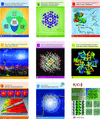issue contents
November 2018 issue

Cover illustration: Ming Han et al. [Acta Cryst. (2018), A74, 616-713] show that a single electron backscatter diffraction (EBSD) pattern can be used for reliable crystallographic characterization of bulk crystalline materials in scanning electron microscopy. The cover image shows an EBSD pattern for tetragonal ZrSiO4. Its Bravais lattice can be accurately reconstructed using only the diffraction geometry extracted from the pattern; no knowledge of the chemical composition or use of a database is required.
advances
research papers
foundations
research papers
 access
accessaddenda and errata


 access
accessinternational union of crystallography

book reviews



 journal menu
journal menu
































